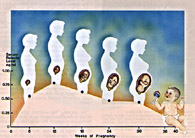
Relaxin birth hormone
1989
drug that makes childbirth easier
Relaxin is a protein that a woman's body produces during pregnancy and childbirth. It softens and opens the cervix, allowing the baby to emerge from the uterus.
If a baby is overdue or needs to be born early, labour might have to be started artificially (induced). Without the natural surge of relaxin just before birth, it is more painful than normal.
Scientists at the Howard Florey Institute developed a synthetic form of human relaxin to make induced childbirth easier. From 1975 to 1992 they worked out the complex structure of human relaxin and developed a way to make it in labs using genetic engineering.
The synthetic relaxin is produced as a gel to be painted onto the cervix before induction begins.
An American company, Connetics Corp, was licensed to produce relaxin. Trials using the drug for other conditions such as sclerosis were taking place in 2000.
Who Did It?
Key Organisations
Howard Florey Institute : research & development
Genentech Inc (USA) : design & manufacture
Key People
Hugh Niall : research team leader
Further Reading
'Director's review'
J P Coghlan
Annual report, Howard Florey Institute, 1990, p 26.
Links
Howard Florey Institute
Connetics
Corp. licenced commercial rights from Genentech Inc
|










